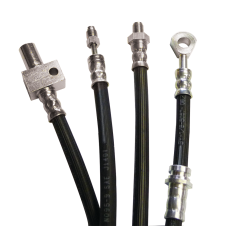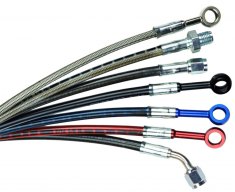Brake Hose
What is a Brake Hose?
A Brake Hose is a flexible conduit that is manufactured to be used in a brake system. This is to be used to transmit or contain fluid pressure of vacuum used to apply brake force to a motor vehicle’s brakes. Brake Hoses, regularly made of either rubber or steel-braided, are designed to be durable for many years. The intention is that they will save you from having to purchase new ones on a regular basis. Its high-quality materials help in the prevention of any kind of fluid leak that can, in turn, cause damage and danger to your motor vehicle. An added incentive is that Brake Hoses do not break under the pressure of any high-speed braking situations you may encounter.
Things to Keep an Eye on
When dealing with Brake Hoses, there are a number of points to always remember:
- They should always fit different types of adapter fittings. This ensures that you won’t have to buy separate adapters, wasting both your time and your money.
- Brake Hoses should provide you with a better pedal feel every time you hit your brakes.
- If Brake Hoses are not made of either rubber or steel-braided materials, you shouldn’t purchase them. Brake Hoses are regularly made of those materials, so any material is not primarily trusted to be durable enough for your vehicle’s use unless they are rubber Brake Hose or stainless-steel braided Brake Hose.
The Signs of When Brake Hoses Have Failed
When using Brake Hoses, there is a number of indications that tell you when your Brake Hoses are not functioning properly, and you maybe need a Brake Hose replacement:
- When there is an apparent leak of hydraulic fluid.
- When unnecessary sounds are made due to the simple pressing your brake pedal on your motor vehicle.
- When there are high temperatures of brake drums.
- When there are unnecessary vibrations when braking.
FAQ about Brake Hose
- What does a brake hose do and how long do they last?
- What does a brake hose do?
- How long should a brake hose last?
A brake hose is an element of automotive plumbing found in hydraulic braking systems. Brake hoses form part of brake lines (the other component in a brake line is a brake pipe) and are found in any vehicle with hydraulic brakes. But what do they actually do, and what happens if and when the time comes to replace a brake hose? The specialists at BrakeQuip have all the answers.
What does a brake hose do?
A brake hose is designed to transport hydraulic pressure from the brake pipes of your vehicle to its wheel cylinders and brake calipers, which is what helps the brakes to engage properly when slowing or stopping. Brake hoses are absolutely vital to the safe operation of a car, motorcycle, truck or any other vehicle using a hydraulic braking system – which is why you must arrange for them to be repaired or replaced as soon as you notice any fault or damage.
Brake hoses are commonly made from hard-wearing, flexible rubber layered with fabric netting, but stainless steel braided versions are also available that are extremely hardy. These are far less prone to wear, expansion and other damage, so they’ll work perfectly for longer, plus they allow for far more precise braking than their rubber counterparts.
How long should a brake hose last?
A basic rubber brake hose should last for up to six years depending on its quality, but this depends on the amount of wear and tear that is experienced by your braking system. If you use your vehicle regularly on tough terrain or in heavy traffic, it’s likely that brake hoses will need replacing earlier. Stainless steel hoses are designed to last far longer and may well outlast the rest of the vehicle!
Brake hoses usually experience consistent wear across a whole system, so if you discover that one is damaged, it’s probably a good idea to have all of them replaced.
If you wish to test your brakes, you should first ensure that your car has cooled down after any use, as hydraulic braking systems can get very hot to the touch. With rubber hoses, you should first undertake a visual inspection, making sure that there are no bubbles, drips, wet patches, cracks or bulges as this indicates that there is damage. You should also feel the hoses manually. If you can feel any swollen or soft parts, they will need replacing.
It is harder to check braided steel brakes for damage, but you will be able to see if there is any distortion or cracking in the metal.
As soon as you become aware of any damage to your brake hoses or the rest of the lines, you should arrange to have them replaced, or change them yourself if you’re confident. For replacements, simply browse our products and contact BrakeQuip today on 01257 220 010 or use our handy contact form to send us a message. Our knowledgeable team will be happy to assist you.
A brake hose is designed to transport hydraulic pressure from the brake pipes of your vehicle to its wheel cylinders and brake calipers, which is what helps the brakes to engage properly when slowing or stopping. Brake hoses are absolutely vital to the safe operation of a car, motorcycle, truck or any other vehicle using a hydraulic braking system – which is why you must arrange for them to be repaired or replaced as soon as you notice any fault or damage.
Brake hoses are commonly made from hard-wearing, flexible rubber layered with fabric netting, but stainless steel braided versions are also available that are extremely hardy. These are far less prone to wear, expansion and other damage, so they’ll work perfectly for longer, plus they allow for far more precise braking than their rubber counterparts.
A basic rubber brake hose should last for up to six years depending on its quality, but this depends on the amount of wear and tear that is experienced by your braking system. If you use your vehicle regularly on tough terrain or in heavy traffic, it’s likely that brake hoses will need replacing earlier. Stainless steel hoses are designed to last far longer and may well outlast the rest of the vehicle!
Brake hoses usually experience consistent wear across a whole system, so if you discover that one is damaged, it’s probably a good idea to have all of them replaced.
If you wish to test your brakes, you should first ensure that your car has cooled down after any use, as hydraulic braking systems can get very hot to the touch. With rubber hoses, you should first undertake a visual inspection, making sure that there are no bubbles, drips, wet patches, cracks or bulges as this indicates that there is damage. You should also feel the hoses manually. If you can feel any swollen or soft parts, they will need replacing.
It is harder to check braided steel brakes for damage, but you will be able to see if there is any distortion or cracking in the metal.
As soon as you become aware of any damage to your brake hoses or the rest of the lines, you should arrange to have them replaced, or change them yourself if you’re confident. For replacements, simply browse our products and contact BrakeQuip today on 01257 220 010 or use our handy contact form to send us a message. Our knowledgeable team will be happy to assist you.




